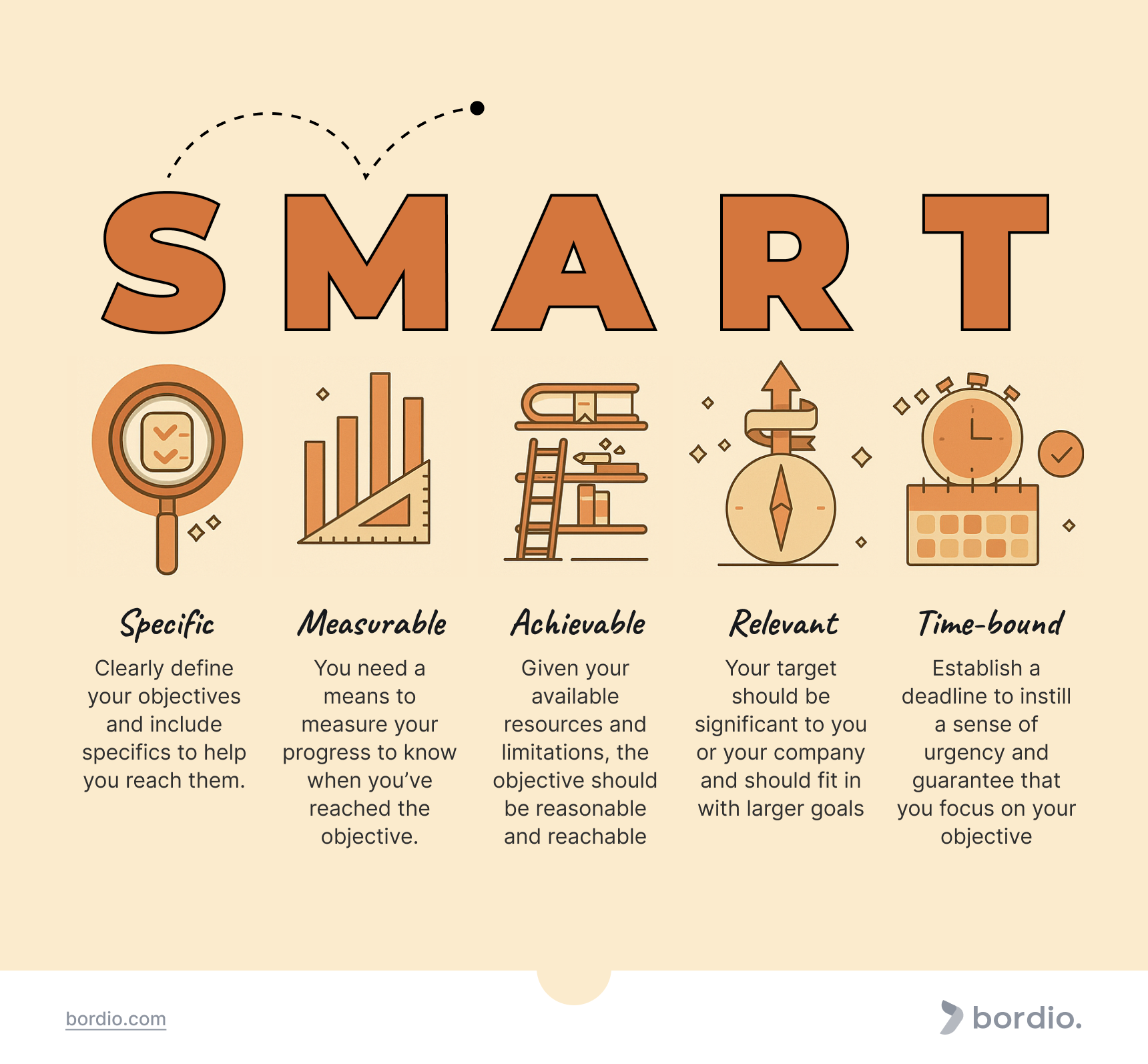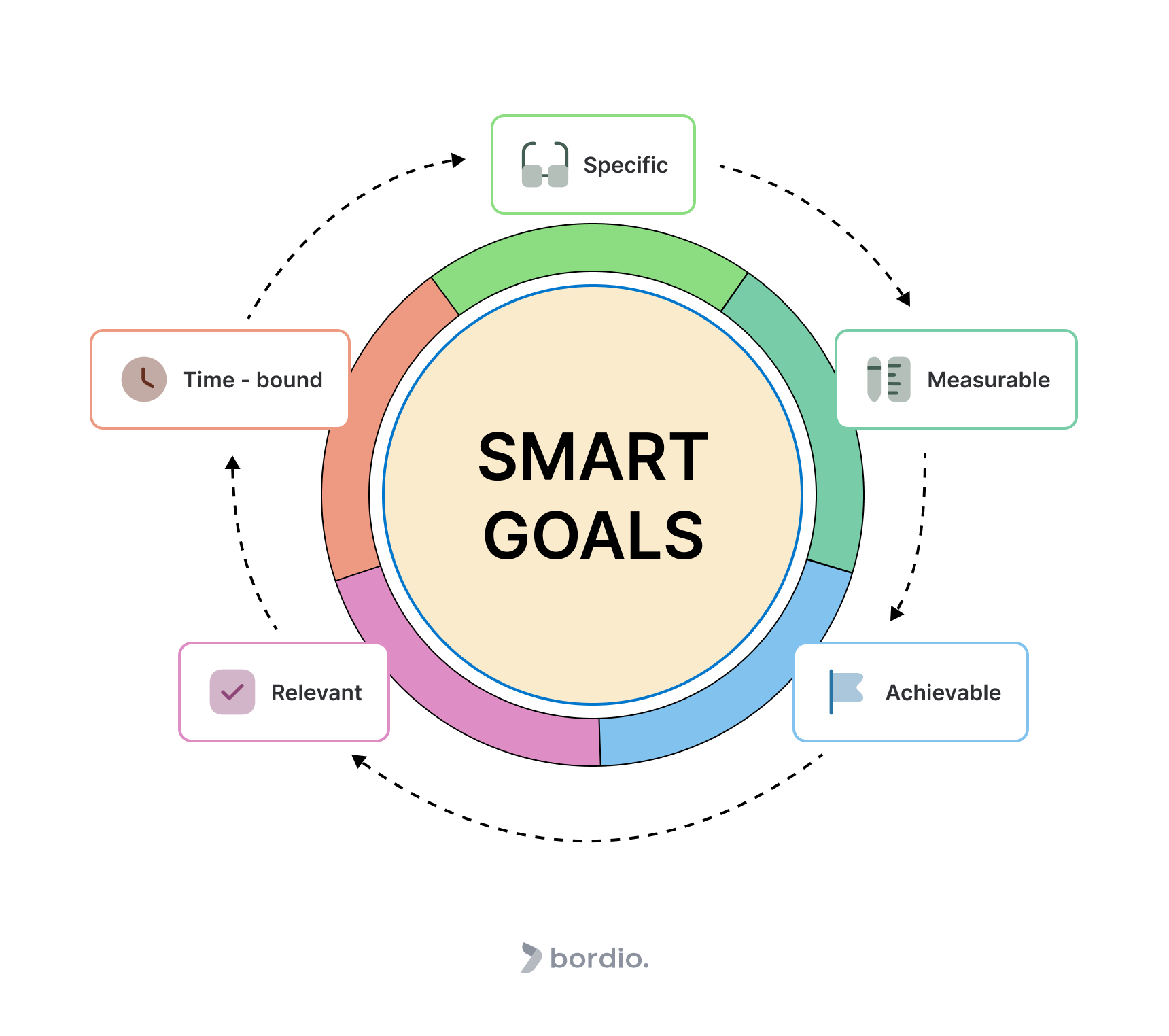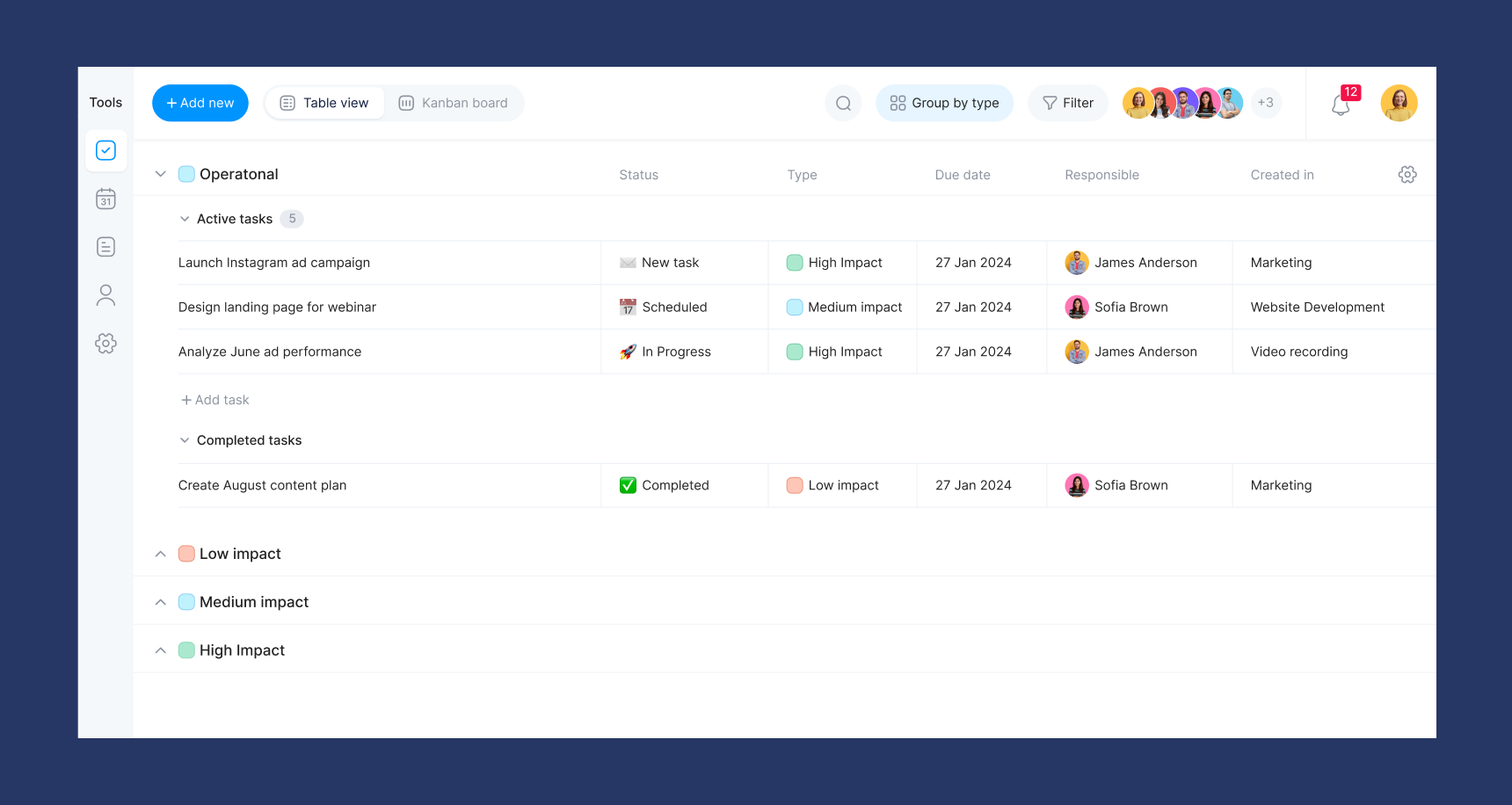There’s a S.M.A.R.T. Way to Write Management’s Goals and Objectives – George T. Doran
Why do some people seem more blessed than others when it comes to achieving goals? In fact, the work itself is not difficult, and the actual game often consists of setting such goals. So, setting goals can make a big difference between success and failure.
Tip: Explore more about “How to set goals?”
That is where SMART goals will come in handy. This uncomplicated and solid structure helps comprehend goals and objectives and puts them in a balanced, easy-to-follow framework. Whether it is a large-scale endeavor or just a desire to advance in an existing skill, clearly defined objectives will provide you with the tools to set goals that will have an impact.
History of SMART Goal Framework
George T. Doran is an American consultant and a former director of corporate planning; however, he is most famous for creating the SMART goals-setting criteria. Due to his background in management and planning, he constructed this framework to guide organizations and individuals to achieve tangible goals effectively.
George T. Doran first used the concept of the SMART framework in 1981 in a paper published entitled ‘‘There’s a SMART way to write Management’s Goals and Objectives.’’ The paper aimed to give managers a way to set audacious and measurable goals.
SMART is one of the most used models, and it can help an organization set goals and achieve them properly. SMART acronym
stands for:
- Specific: Clearly define your objectives and include specifics to help you reach them.
- Measurable: You need a means to measure your progress to know when you’ve reached the objective.
- Achievable: Given your available resources and limitations, the objective should be reasonable and reachable.
- Relevant: Your target should be significant to you or your company and should fit in with larger goals.
- Time-bound: Establish a deadline to instill a sense of urgency and guarantee that you focus on your objective.
Each goal should be specific, measurable, achievable, relevant, and time-bound to ensure clarity, trackability, and attainability, thus forming a roadmap for personal and professional success.
How to set SMART Goals: A step-by-step guide
SMART goals are easy to understand, but how do we make it work for us? Here, we provide a step-by-step guide on how to implement SMART goals:
1. Decide what you want to achieve using smart objective
When setting SMART goals, it’s helpful to understand the different types of objectives you might focus on, ensuring they are relevant goals that align with broader company priorities and trends within the industry. Here’s a more narrative exploration of common goal types:
Increase Something: In many cases, goals are set about growth. This type of goal is used when you want to improve on something, get more sales, increase participation, or improve some area of one’s life or job. For instance, set a target of raising the number of weekly exercise sessions from two to four or raising the team project completion percentage from 70% to 90% in the next quarter.
Tip: Read more about setting weekly goals with examples!
Create Something: Creation goals aim to create something new. This could be a new product, a marketing strategy, or blogging, among other things. In this case, the emphasis is on creativity and creating something new from the ground up.
Improve Something: Evaluative goals involve a search for improvement in every factor. This could be improving existing skills or proficiency, tracking team productivity, fine-tuning a process, or improving results.
Reduce Something: When writing goals centered around reduction, one has to develop a goal to lower something undesirable. This might imply cutting costs, losses, errors, and anything detrimental to the process.
Save Something: Saving objectives center capital accumulation on money, time, or tangible or intangible assets. This could include spending less while shopping, using fewer resources in the home, or setting up a piggy bank for a particular venture.
Develop Someone: Development objectives involve positive change or progress for oneself or others. This could refer to expanding one’s competencies, coaching other staff members, or creating learning opportunities.
2. Implement some metrics into your goals
After setting your goals, make sure you have a way to measure them. How will you know when you’ve reached your goal? For example, just saying you want to lose weight isn’t enough. Your goal should be measurable to see if you’re on track. Saying “lose 10 kg” is more specific and easier to measure than just saying “lose weight.”
This goes for all goals. If you want to increase sales, decide how much—by 20% or 100%?
Instead of saying, “I want a promotion”, set a measurable goal like, “I want to boost my sales by 15% in the next six months to qualify for a promotion.” Or instead of “I want to read more,” say, “I want to read 12 books this year, averaging one book each month.”
3. Make sure it’s an achievable goal
Sometimes we set goals that are unrealistic. For example, it would be unreasonable to aim to make $1 million in the next 12 months if you’re still a student.
Similarly, if you’re making $100K in monthly sales, aiming for $300K next month is highly unlikely.
Don’t get us wrong—SMART goals shouldn’t be too easy. They should be challenging but not impossible. Just make sure your goal, especially with specific metrics, isn’t too extreme. Otherwise, your team (if you have one) might feel discouraged by such a big target.
4. Make sure it’s relevant
Is your goal relevant? This step makes sure that your goal fits with your bigger vision and is important to you. It’s easy to get distracted when you have multiple goals, but trying to focus on too many things at once can stop you from making progress.
Steve Jobs’ approach is a great example of staying focused. He was known for focusing on one main goal at a time and cutting through distractions. By making the most important projects his top priority, he achieved huge success at Apple with his intense focus.
Tip: You can also check out other prioritization methods like the Eisenhower matrix or abcde method!
When assessing your goal’s relevance, consider these crucial questions for yourself:
- Does this objective fit within my long-term plan?
- Is it appropriate to pursue this objective at this time?
- Will this objective have a significant effect?
Focusing on something that counts and will get you closer to your long-term goals positions you for success. Make sure your objective is relevant. Ensure that each goal aligns with your overall strategy and concentrate on quality rather than quantity.
5. Set a specific, time-bound deadline
If you decide to lose 10 kg but don’t set a deadline, you might never get there. That’s why having a timeframe is important for any goal. The timeline really matters. Want to lose 10 kg in a year? No problem—you’ve got plenty of time. But if you’re aiming to drop 10 kg in just a month, you’d better stop what you’re doing and get moving right away!
SMART Goals Examples
Here are “ultimate goal” examples from different areas of life and business, illustrating how to apply the SMART criteria:
Personal SMART Goals Examples
- “I’ll drop 5 kg in the next three months by eating a balanced diet and going to the gym three times a week.”
- “I’m going to read 12 novels this year if I set aside 30 minutes daily.”
- “By deducting $500 from my monthly wage, I want to save $3,000 over the following six months.”
- “To relieve tension, I will meditate for ten minutes every morning for thirty days.”
- “I’ll practice Duolingo for 20 minutes daily and learn 100 new Spanish words in four weeks.”
Business SMART Goals Examples
- “I need to increase sales by 20% in the next six months by improving website SEO and launching a targeted marketing campaign for business success.”
- “I am gonna increase our Instagram followers by 15% in the next two months by posting content daily and running targeted ads.”
- “Over the next three months, I will organize bi-weekly workshops to train 20 employees in customer service skills.”
- “I will increase our website traffic by 30% in the next five months by optimizing content for SEO and running Google Ads.”
- “I will attend five industry conferences this year to expand my professional network and gain new business leads.”
If you need more SMART goals examples, explore more in our latest article – 25 SMART Goals Examples with PDF Template!
How to achieve SMART Goals?
Now that you’ve determined your objectives, let’s discuss how to write SMART goals to reach them. While setting objectives is essential, it’s only the first step. We suggest using a task planner or calendar like Bordio to plan the next steps toward reaching your goals.
Create a project for each of your goals
Organizing your objectives into discrete projects will significantly improve your approach to completing them. By organizing tasks into clearly defined projects, you may plan your work rationally and make it simpler to comprehend what has to be done and in what sequence. This makes each goal’s way ahead obvious and helps avoid misunderstanding.
Using the Bordio project task tracker to create and manage projects simplifies this process. The platform allows you to manage multiple projects simultaneously, making it possible to create a distinct project for each goal. For instance, if one of your goals is to “Improve Time Management,” you can create a specific project within the Bordio project planning board dedicated to that, including tasks like “Set up time blocks” or “Track daily activities.”
This project management task list also offers the flexibility of effortlessly switching between projects, which is especially useful when your priorities shift during the day or week. This seamless transition helps you focus on different goals without losing track of any specific task. Within each project, Bordio enables task prioritization by setting types, allowing you to set which tasks need immediate attention and ensuring you stay aligned with your most critical objectives.
Break down your goal into small actionable steps
Now, consider what actions you can take to achieve your goal. You can use Bordio’s waiting list for all those tasks, which is perfect for managing the small actionable steps that don’t need immediate attention but will require focus later. Instead of juggling all tasks simultaneously, you can add these steps to the waiting list and shift them to your priority list when the time comes.
Here’s how you can use Bordio’s waiting list:
- Add Non-Urgent Tasks: Place tasks that are not yet urgent or require prerequisites to be completed first. Your waiting list can work as a backlog for tasks. This way, you can focus on what needs immediate attention while keeping future steps organized.
- Review Regularly: Periodically check your waiting list to see if any tasks should be moved to the active list or the Kanban board as priorities change or deadlines approach.
- Ease of Transition: When you’re ready to start working on a task from the waiting list, you can move it to your active projects with just a click. You can immediately assign it to any team member, keeping everything fluid and easy to manage. That makes this team task board especially useful for remote work.
Set impact for each task
Sometimes, you will have many tasks and ideas for achieving your goal, but not all are equally important. So, you need to set the impact of each task and then focus on the most impactful actions first. You can use various prioritization methods, such as the Eisenhower Matrix or the ABCDE Method.
Tip: Day Theming is another method of focusing on essential tasks and fitting in with deadlines.
In Bordio, you can configure Types for tasks in your project and make it, for example:
- Low impact (Orange)
- Medium impact (Blue)
- High Impact (Green)
These techniques will help you categorize your tasks by priority. While using a Kanban board, you can easily distinguish more critical tasks to focus on by using color-coded task cards.
Schedule those activities in your calendar
Finally, you need to schedule those activities. You have 25 actions/tasks to complete to achieve your goal. Now, you need to plan when you will work on them.
If you are using the Bordio team tracker, it is very simple. So far, all your tasks have been on the waiting list, and now all you need to do is move them to your Calendar. Once you’re ready to schedule them, drag and drop the tasks from the waiting list on the appropriate target date on your calendar, or use one of the Bordio views, Kanban board, or Table view.
The Kanban board helps you see your team’s workload, offering a more visual representation of where tasks are located in the status columns and allowing you to reveal details with a click. The Table view, on the other hand, presents tasks in a list format, where you can quickly see brief information about each task in a single line. This way, it’s easier to balance the workload levels of the team.
Start working on those tasks according to the plan
Now, when you have a specific plan, you only need to work on them. Remember that without execution, you will not achieve anything. So, to achieve your goals, you need to take actions that will move you closer toward your goals.
Whenever you complete a task, mark it as Completed in Bordio. Soon, you will see the progress. If you open a Kanban board in your goal’s project, you will see how many tasks have been completed and how many are still active (need to be done).
Additional tips for staying on track with SMART Goals
Here are some tips on staying on track with SMART goals:
Regular reviews to track progress
Reviewing your progress regularly helps you stay accountable and determine whether you’re on course to meet your objective. It also assists you in locating roadblocks, calculating achievements, and modifying as needed.
Establish a regular review plan for your goals. Depending on the goal’s timing, this may be weekly, biweekly, or monthly. As you go through these evaluations, consider the following:
- Are you meeting the milestones you set?
- Are there any unexpected challenges you need to address?
- What is working well and what isn’t?
- Do the timelines need to be adjusted, or are they realistic?
Bordio is an excellent tool for conducting regular check-ins. You can set reminders, track your task progress, and update your project board. In Bordio, you can create task lists under each goal, assign deadlines, and prioritize tasks. During reviews, use Bordio’s work productivity tracking features to mark completed tasks and identify any outstanding ones. It helps you visualize your progress, see what needs more attention, and plan effectively. After review, you can leave online chat feedback under each task you create.
Adjusting goals
Because life is unpredictable, there are times when circumstances change, and the initial aim becomes irrelevant or unachievable. If you are adaptable and willing to adjust, your objectives will stay attainable and aligned with your present priorities.
Don’t be scared to change your objectives as needed. During your frequent evaluations, consider if the aim is still relevant or whether you need to adjust the timetable, resources, or method. For instance, extend the deadline or divide the objective into smaller, more doable tasks if your timeframe is too tight or if other circumstances have made accomplishing the goal unfeasible.
Key considerations:
- Timing: Are your deadlines realistic, or do they need an extension?
- Resources: Do you have everything you need to achieve the goal, or should you seek additional resources?
- Priorities: Does this aim fit into your overall plans, or has it been superseded by something more urgent? Do you use appropriate prioritization techniques?
The platform allows you to easily adjust target dates, reassign tasks, and re-prioritize activities. Bordio’s intuitive interface allows you to modify tasks and see their impact on your overall progress, making goal adjustments smooth and efficient.
Final Thoughts of SMART Goals
SMART goals offer a concise, workable structure for establishing and accomplishing goals. By including a project management planner like Bordio, you can improve your goal-setting process and ensure you stay on pace to reach your objectives.










